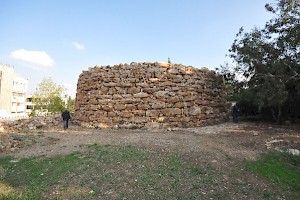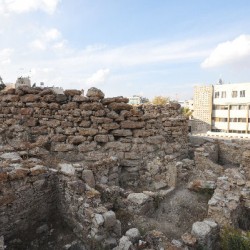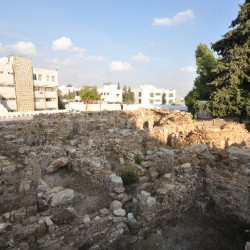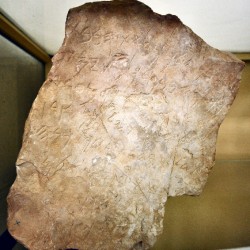Rujm al-Malfouf
Q3805Rujm al-Malfouf: Iron Age fortification in the western suburbs of Amman (Jordan), built by the Ammonites.

The ruins of Rujm al-Malfouf consist of a stone tower and several store rooms east of it. The buildings are situated on a hilltop (rujm), and the traces of three levels can still be recognized; it may have been higher than today's five, six meters. The circular tower has a diameter of twenty-two meter (malfouf means something like "round tower").
The first researchers believed that it was built in the second half of the first century BCE by the Romans who occupied Philadelphia (as Amman was called back then). One indication was the presence of Roman sherds. However, when Roman masonry styles became better know, this interpretation was ruled out, and when the site was professionally excavated, it turned out that most ceramics belonged to the first half of the first millennium BCE, the Iron Age. The fortification was, therefore, built by the Ammonites, and reused in the Roman age.
The main questions, however, are still unanswered: when exactly was the tower constructed, and why? If the fortification was built in the first half of the tenth century, it was intended to defend the Ammonites against king David of Judah.note If, on the other hand, the structure dates back to the second half of the tenth or first half of the ninth century, the enemy was the kingdom of Israel. A third possibility is that it was built in the late eighth or seventh century, when the Assyrian armies threatened Ammon. Even a sixth-century date is possible, in which case Babylonian or Persian aggression may have been the stimulus for erecting this tower, together with some thirty others in the kingdom of the Ammonites. It is also possible that the towers were built to protect the harvest in the store rooms against nomads. Of course, the various hypotheses are not mutually exclusive.
 Rujm al-Malfouf, storerooms and tower |
 Rujm al-Malfouf, Storerooms |
 Rujm al-Malfouf, Storerooms |
 Amman, Citadel Inscription |
Things are made more complex by a tantalizing inscription that was found on the citadel of Amman, four kilometers east of Rujm al-Malfouf. It dates to the ninth century and seems to mention how the supreme god Milkom orders the construction of fortifications. However, although this is a tantalizing text, it is by no means certain that it refers to the construction of Ammonite towers like Rujm al-Malfouf. In any case, this Iron Age building helps us understand what the Judaean prophet Isaiah had in mind when he compared a fort to both "a high tower" and "a fenced wall".note